
Science in Ancient Artwork and Science Today
The Theoretical Interpretation of Spacetime/motion
|
|
|
|
|
THE TEMPLE OF QUETZALCOATL:
A 64/66 COUNT
By
Charles William. Johnson
Introduction
This essay presents a theoretical reconstruction of the method of calculation that may possibly have been employed in the relationship between Venus cycles (65 count) and the full lunar cycles (64 count). For this exercise, we have chosen the quantifiable elements of serpent-head figures (Quetzalcoatl), and those which have been identified as the rain god (Tlaloc), on the Temple of Quetzalcoatl at the pyramid site of Teotihuacan, Mexico.
Tlaloc & Quetzalcoatl
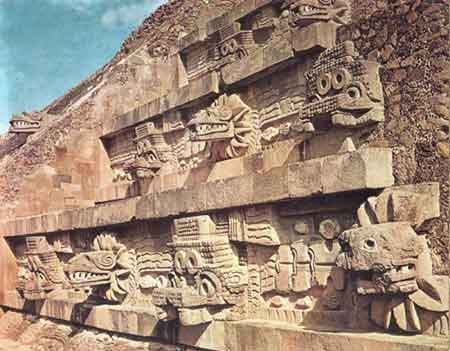
Teotihuacan: The Floorplan
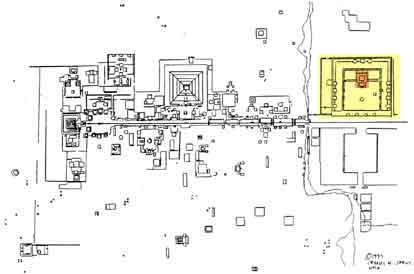
The exact number of figures that originally adorned the temple remains questionable, due to the fact that only a part of the temple was found relatively intact on the wall facing west.
(La Ciudadela: The Temple
of Quetzalcoatl)
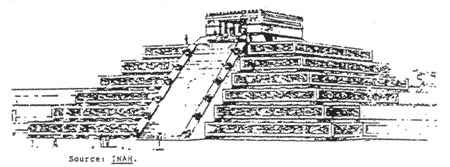
A theoretical reconstruction of the temple’s configuration was made by INAH (Instituto Nacional de Antropología e Historia; México). At one time, in INAH’s 1966 official guide to the pyramids of Teotihuacan, it was stated that the temple consisted of only six levels. INAH made a more recent projection where it is now believed that the temple originally consisted of seven levels (without counting the pavilion on the uppermost level).

For the purposes of this analysis, we shall work with the seven-level reconstruction.
The Seven Level Theoretical
Reconstruction of
The Temple of Quetzalcoatl (Teotihuacan)
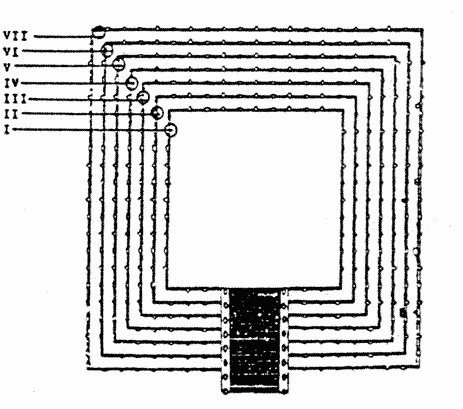
The exact number of elements on the temple may be incorrectly reconstructed. Nevertheless, the numerical exercise involves a logic of its own. Although a specific monument has been chosen for this analysis, one could actually carry on this discussion around the numerical quantities themselves, without reference to a particular monument. For the sake of a visualization of the numbers, we have selected the Temple of Quetzalcoatl, and distinct day/year/cycle counts. We have selected the 65c of Venus, alonwith the 64/66c, which appears to pertain to the Earth’s moon. We shall also be making reference at times to the 52c cycle relating to Earth’s 365 day-count. We expect to show that the 64/66c may serve as a repeat pattern of numbers (or cycles) that relates Venus’ cycles to the full lunar cycles.
Let us first explain, however, how we happened upon the 64/66 count of cycles.
The 64/66 count of Cycles
In The Mayan Factor, the author, José
Argüelles, treats different aspects of the maya counting system
and discusses a possible link between the I Ching and the ancient
260c calendar known as the Tzolkin. Mr. Argüelles cites a
series of numbers derived from the I Ching and the magic square
of Benjamín Franklin, which yield linear sums of 260; the same
count that corresponds to the Tzolkin.
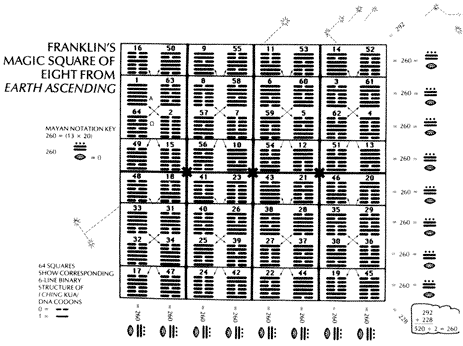 |
|
Soruce:
The Maya Factor, José Arguelles. |
The table illustrated above may be considered
in distinct manners. Mr. Argüelles identified a pattern of movement
by connecting in sequence the 64 numbers on the table.
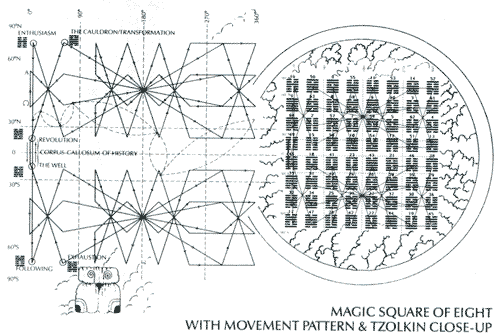 |
|
Soruce:
The Maya Factor, José Arguelles. |
There are other options. One is to connect the pairs of numbers alone (1-2, 3-4. 5-6. 7-8, etc.), without drawing the connecting lines between the pairs. In this manner a starburst pattern evolves.
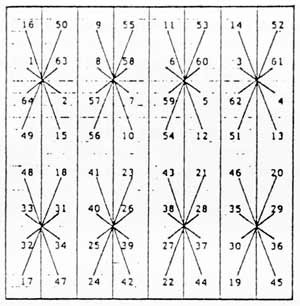
Within this illustration there appears to be a method for adding up the distinct pairs of numbers as follows:
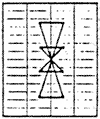 |
|
These pairs may also be conceptualized in the following manner:

At this point, it occurred to us that one might be able to apply such a sequence of numbers to the paired figures such as the ones on the temple of Quetzalcoatl.
Assigning abstracted values to particular events may also be considered an arbitrary act. Hence, we qualified our initial statement of purpose by deeming this an exercise. With that idea in mind, let us assign either a 64c or a 66c to the figures that are placed on the walls of the Temple of Quetzalcoatl, in order to see how they perform. Maintain in mind that we are relating distinct orderings of numbering systems that pertain to the ancient record; hence, the possible linkage that mr. Argüelles proposes.
We shall assign the number 64 to the serpent-head figures of Quetzalcoatl, and the number 66 to the rain god figure of Tlaloc. We chose such an alternative because we consider that Quetzalcoatl, the serpent, represents the full lunar cycle of 64 years.
From the illustration, one will observe that the figures alternate one another on each side, but confront one another at the corners of the distinct levels.
The 64/66c Assigned to the Figures of The Temple of Quetzalcoatl
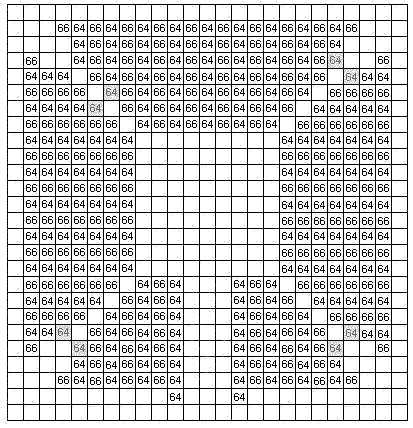
24880 Total
A problem arises immediately in assigning the values due to the theoretical reconstruction of the Temple of Quetzalcoatl. As we mentioned, the INAH illustration shows eight serpent-head figures drawn with dotted lines, suggesting doubt about their existence. The question arises, then, as to whether we should assign them a value or not. In the previous illustration we assigned them a value; in the following illustration, we have presented them with no value assigned.
The 64/66c Assigned to the Figures
of
The Temple of Quetzalcoatl Without Eight Serpent-Head Figures
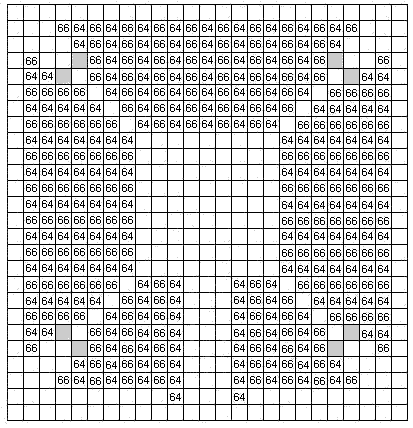
24368 Total
There are other alternatives in carrying out the distinct sums of the assigned values, as we shall discuss below. For now it is sufficient to comment that the different grand totals appear to offer little understanding of the assigned values.
Before we continue with our analysis of the values, a few comments are in order to place the logic of discussion in context.
It is not agreed upon who were the peoples who constructed the pyramids at teotihuacan, whether they were maya or some other people is under debate. However, the maya numbering and counting system appears to have had extensive influence in ancient Mesoamerica and Mexico. A characteristic of that system was the positioning of numerals (or symbols) which caused them to acquire distinct values. Such a procedure would explain in part the possibility of a single symbol (or number) representing distinct counts, depending upon its position or relation to the whole.
This reminds us of the discussion regarding the number of elements that were initially considered to exist on the Aztec Calendar (thought to be from the mexica culture). It was argued over one-hundred years ago that the relief sculpture of the Aztec Calendar implied the existence of elements that were not visible on the calendar’s sculpted image, but which were suggested to be present or accounted for in the calculations. Other authors debated this possibility, and emphatically denied a procedure that would take into account elements that were not shown. It was then held that only the visible elements were to be counted.
With time, however, it became a common practice to take into consideration the elements that were not actually sculpted on the stone’s image. The same rule of thumb seems to apply also to the Temple of Quetzalcoatl. The repeat pattern of the figures of Quetzalcoatl and Tlaloc suggests that one might consider the elements that would exist under the stairway on the west wall, for example.
It may be, then, that this is not an either/or situation, but rather an inclusive one, whereby both possibilities are admissible for making distinct calculations. Such an alternative would allow for a greater number of symbolic representations. The reckoning system should take into account the visible elements and the elements that are suggested to exist if the repeat pattern were carried out across the entire structure of the temple. It is this inclusive procedure which serves as the basis for our analysis of the Temple of Quetzalcoatl.
Therefore, as we mentioned earlier, we may not know exactly how many stone figures originally existed on a particular monument, but he logic of the numbers might assist us in comprehending the distinct alternatives, and even the possible meanings. This analysis attempts just such a task.
To continue with our analysis, once the numbers of the 64/66c are assigned to each alternate figure on the temple, we then proceed to add up the values on one of the three sides that present the same sequence of figures: the north, east, and south walls. The west wall will be dealt with individually later.
If the serpent-head figures represent the number 64 and the Tlaloc figures represent the number 66, then the addition of the nine figures to a side on Level I total the number 584. (We shall refer to the north wall for this sequence of examples.)
|
64 66 64 66 64 66 64 66 64 |
= 584 |
The number 584 may be readily recognized as the 584c that constitutes the Venus cycle of 584 days. An even number of 64c figures and 66c figures would average out to a value of 65; but nine 65c figures would equal 585.
On Level II there are two additional Tlaloc figures, therefore representing a sum of 132 greater than level I:
|
66 64 66 64 66 64 66 64 66 64 66 |
= 716 |
One should note that the line of figures follows a sequence that begins and ends with a Tlaloc, figure, whereas Level I began and ended with a serpent-head figure.
Level III presents 13 figures, in a sequence beginning and ending with a serpent-head figure (as on Level I), which totals 844 days:
|
64 66 64 66 64 66 64 66 64 66 64 66 64 |
= 844 |
Level IV on the north wall reveals a pattern similar to Level II, beginning and ending with a Tlaloc figure, whose 15 elements total 976 days:
|
66 64 66 64 66 64 66 64 66 64 66 64 66 64 66 |
= 976 |
As we stated earlier, Level V presents an unclear picture as to how many figures it involves. If the north wall begins and ends with a serpent-head figure on Level V, the the total value of that lined sequence is the same as the next level (1104 days). However, if the serpent-head figures were not originally present on that level, then the total would be the same as Level IV (976 days). Neither one of these alternatives (1104 and 976 days) convinces us. We shall discuss later a distinct alternative of the number of figures on Level V.
The north wall of Level VI represents values of 1104 days, since it consists of 17 figures, beginning and ending with a serpent-head figure:
|
64 66 64 66 64 66 64 66 64 66 64 66 64 66 64 66 64 |
= 1104 |
Level VII begins and ends with a Tlaloc figure, and consists of 19 figures, with a total of 1236 days:
|
66 64 66 64 66 64 66 64 66 64 66 64 66 64 66 64 66 64 66 |
= 1236 |
THE TEMPLE OF QUETZALCOATL
The Repeat Pattern of the North,
East, and South Walls
Projected onto the West Wall
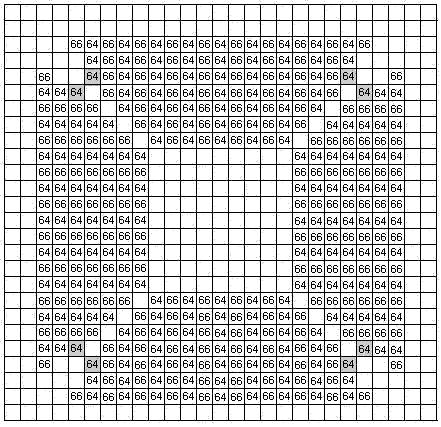
26,256c Total
In summary, the corresponding number of days per level on the north, east and south walls of the temple of Quetzalcoatl are as follows:
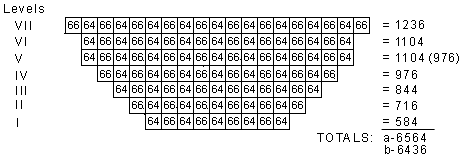 |
The above illustration represents the repeat pattern on the north, east, and south walls of the Temple of Quetzalcoatl.
Level V: A Proposal
In order to be able to proceed in our analysis, however, the question regarding the presence/absence of the 8 serpent-head figures on Level V must be addressed. Let us assign therefore one serpent-head figure to each side of the four walls on Level V. When one 64c serpent-head figure is thus assigned, the value of that sequence then becomes 1040; a most significant cycle number in ancient reckoning. For example, consider ten Great Cycles of 104 years equal 1040 year.
The 64/66c of Level V, thusly arranged, would appear as the following sequence:
|
(64) 66 64 66 64 66 64 66 64 66 64 66 64 66 64 66 |
= 1040 |
The logic of the sequence appears to be broken, because now the line begins and ends with an opposite figure; which also means that the 64/66c is thereby averaged out to a 65c (1040 divided by 65 = 16).
The number of absolute figures on each of the three walls (north, east and south follows a sequence of:
|
Level I |
= |
9 |
Figures |
|
Level II |
= |
11 |
" |
|
Level III |
= |
13 |
" |
|
Level IV |
= |
15 |
" |
|
Level V |
= |
(16) |
" |
|
Level VI |
= |
17 |
" |
|
Level VII |
= |
19 |
" |
| Total |
100 |
Figures |
The total value of the north, east, and south walls now changes by adding only one serpent-head figure to Level V: the total is now 6500c.
 |
The 6500 values, per side, is of great significance. On a year-count it could possibly reflect 100 65-year cycles of Venus (Which would equal 125 52-year cycles of Earth).
Furthermore, if the west wall were the same configuration as the other three walls, then the grand total for the entire temple would be 26,000 (4 X 6500 = 26,000), which could possibly represent 100 Tzolkins (the old 260c calendar), which consist of 26,000 days.
Another interpretation could be, that if there were actually 400 figures of the 65c on the temple (an average of the 200 64c and 200 66c figures), given that the four walls were consisting of 100 figures each, then each figure (of Quetzalcoatl and Tlaloc) might thereby represent 23,725 days each, pertaining to the 9,490,000 days that make up a Great Sun Cycle of 26,000 years (setting Leap Years aside). The 65c for each of the possible 400 figures could also represent the 65-year cycle of the 584c, which again equals the 104-year cycle of the 365c.

One hundred 65c figures to a side =
6500
4 x 6500 = 26,000 Total
THE TEMPLE OF QUETZALCOATL
The Repeat Pattern of the North,
East, and South Walls
Projected onto the West Wall
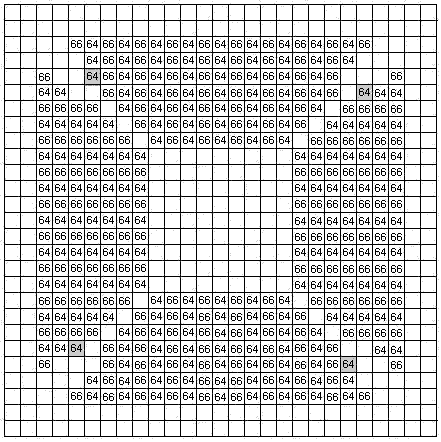
26,000c Total
From the viewpoint of aesthetics and repeat patterns, it may appear logical that there be 8 serpent-head figures on level V on the temple. From the perspective of symbolic, representational values and counts there need not be 8, but only a total of 4 serpent-head figures placed in the manner in which we have suggested.
In summary, there are 363 visible elements on the temple of Quetzalcoatl on the distinct levels, plus the 16 serpent-head figures on either side of the stairway, there are 400 visible and suggested figures on the four walls of the temple.
The West Wall
As we have examined, the north, east, and south walls of the temple of Quetzalcoatl present an explicit repeat pattern, with the exception of the questionable serpent-head figures on Level V. The west wall is further complicated by the stairway and its figures, alongwith the possibility of its covering figures in a hidden manner, as we have discussed. Consider the visible elements on the west wall to either side of the stairway; in relation to our analysis of the 64/66c and the different figures cited:
The West Wall's Visible Figures(Without the figures on the stairway)
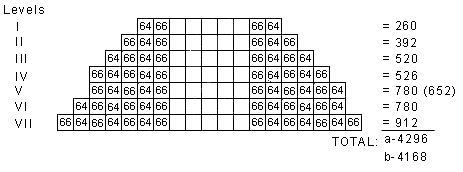
It would appear that the stairway is relevant for calculating values and counts, and does not represent an arbitrary width measurement. It covers a specific number of figures that may relate to a particular calculation, whereby the number of figures hidden by the stairway is by design and numerical necessity. The stairway covers a 2268c (of the 64/66c)
Furthermore, there are 16 serpent-head figures on the siderails of the stairway (8 to either side). Thus, each side of the stairway represents a 512c (of days/years). 512 days represents 7/8ths of a Venus cycle of 584c.
The counts for the distinct levels of the west wall are:
|
Levels: |
|||||
|
I |
130 |
+ |
130 |
= |
260 |
|
II |
196 |
+ |
196 |
= |
392 |
|
III |
260 |
+ |
260 |
= |
520 |
|
IV |
326 |
+ |
326 |
= |
652 |
|
V |
326 |
+ |
390 |
= |
(716) |
|
VI |
390 |
+ |
390 |
= |
780 |
|
VII |
456 |
+ |
456 |
= |
912 |
|
Totals: |
2084 |
+ |
2148 |
= |
4232 |
The grand total for the west wall in this alternative would involve adding the count of the 16 Quetzalcoatl figures lining the siderails of the stairway:
| 16 X 64 | = | 1024 |
| + | 4232 | |
| ---------- | ||
| 5256 |
In the above numbers, one can easily recognize significant cycle numbers that are prevelant in ancient calendar reckonings: 130, 260, 326, 390, 520, 780, etc.
This level of analysis for the visible elements of the west wall, reveal a count for the entire structure as follows:
| North wall | = | 6500 |
| East wall | = | 6500 |
| South wall | = | 6500 |
| West wall | = | 5256 |
| 24756c |
Some considerations about whole cycles
Interestingly, with regards to the Moon, 26000 divided by 64 (a full lunar cycle) equals 406.25, which means that in the Great Sun Cycle that amount of full lunar cycles occur. With regard to comparisons of whole cycles, consider then the following.
On our projection of the temple’s figure count, there are 16 full lunar cycle elements (Quetzalcoatl figures) on the siderails of the stairway. Plus there are 179 visible serpent-head figures represented on the four walls, In total here are 195 (189 + 16) visible full lunar cycle figures of of Quetzalcoatl on the temple’s four walls.
| 195 X 64 years = 12480 years |
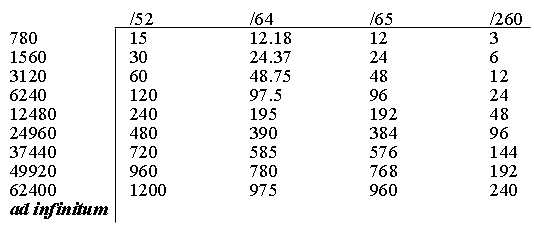
The possibilities for deriving an infinite array of comparisons among the distinct counts are mind-boggling. Consider the following extract, which offers a selected few in relation to the 12480c as derived from the symbolic representation of the temple.
The Visible Quetzalcoatl (64c) Figures
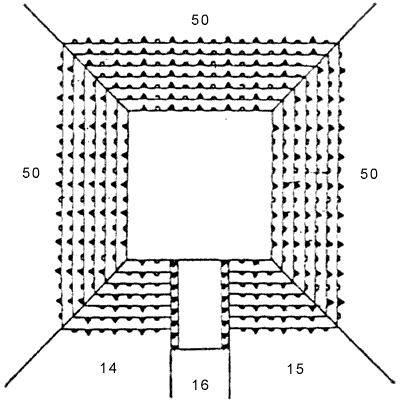
The possibilities for deriving various calculations are in fact infinite.
Along this same line of reasoning, whereby there is an enormous flexibility in being able to make calculations from the distinct counts in relation to the temple’s elements, consider another example. Notice that a count of the visible and the hidden Tlaloc figures (66c) would yield the following:
200 figures X 66 years = 13200 years
If we then add the visible 64c to the visible and hidden 66c, we then obtain:

The sum of 25680 years equals 401.25 full lunar cycles, while 400 times 64 equals exactly 25600 years.
In the following table, we offer a general view of whole cycles in relation to distint counts.
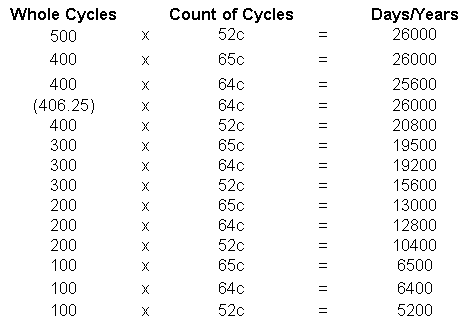
The possibilities for calculation of whole cycles and their comparisons are infinite. In this manner, the 64/66c allows one to calculate and achieve numerical representations that range from the 584 day-count of Venus’ orbit to the 26000 years (365c) of the Great Sun cycle. It is understandable that the elements arranged as such on the temple of Quetzalcoatl allow for deriving any calculation within that range, and beyond it an infinitum.
The Temple of Quetzalcoatl, form the conclusions reached in this analysis, would appear to represent the significant time cycles of venus, the Sun and the Moon with the 365c serving as the basis of the reckoning. For we should remember, that all of the cycle counts (52c, 64c, 65c, 66c, 260c and the 584c) are in fact in reference to the 365c of earth’s orbit. The obvious achievement of ancient astronomers was to comprehend how to make comparisons of whole cycles of these particular counts as of a counting system possibly similar to the one analyzed in this essay.
Observations
The coincidence of numbers, values, counts, cycles, and possible numbers of figures on the temple of Quetzalcoatl seems far too precise to be readily attributed to mere chance. The count of cycles (days/years) appears to have resembled the reasoning that has been reflected in this exercise. The relation of whole cycles of distinct day/year counts is made possible by the method of calculation derived herein.
The 64/66c also would appear to have a linkage with the number arrangements as dicated in the I Ching, although that may require a study of its own. Nonentheless, it is not surprising to observe a reasonable link among different counting systems anchored in cultures thousands of years old. All of the ancient cultures were studying, in fact, the same sky, the same Sun, the same moon, the same Venus. To have derived similar mathematical resolutions to the question of whole cycles of time should not strike us as surprising. The linkage among the different systems could be based on direct contact, as some analysts hold, while there could also be simply a linkage derived from studying the same problematique.
A positional system of analysis, where a single element may enjoy meanings, depending upon the relationship of the elements to themselves, might produce in some readers a certain uneasiness. We are used to searching for and coming up with one particular meaning or interpretation to reality. We enjoy answering questions such as, "What does the Temple of Quetzalcoatl mean", with a single, definitive answer. To pose the idea that the temple possibly represents in itself a system of calculation, whose elements may be manipulated to derive an infinite array of meanings and answers, might be exasperating in a sense. This would also imply, that all of the propositions forwarded in this essay, in fact, might represent one aspect of the infinite possibilities and meanings that the temple was designed to portray. In fact, we may never fathom all of the meanings that were possibly assigned to it by the creators of the temple of Quetzalcoatl.
Personally, I consider that we have only
touched upon one aspect of the temple and its numerical significance;
especially, when I begin to consider that certain numbers on the temple
approximate a relationship of pi ( ![]() ):
):
|
1024 divided by 326 = 3.14110429447 |
The relation 1024/326 is taken from the west wall. There may be other intriguing examples on the other walls as well.
*****
The Temple of Quetzalcoatl: 64/66
count. ISBN 1-58616-344-2
©1995-2003 Copyrighted by Charles William Johnson. All rights reserved.
Earth/matriX: Science in Ancient Artwork. P. O. Box 231126, New Orleans,
LA 70183-1126.
Bibliography
Arguelles, Jose, THE MAYAN FACTOR: PATH BEYOND TECHNOLOGY, Bear&
Co., Sante Fe, New Mexico, 1987, 221pp.
Instituto Nacional de Antropología e Historia. INAH, TEOTIHUACAN:
OFFICIAL GUIDE, INAH, Mexico, 1968, 62pp.
"The Temple of Quetzalcoatl: 64/66 count."
Science in Ancient Artwork
Series No.9
24 February 1995
©1995-2013 Copyrighted by Charles W. Johnson. All Rights Reserved
johnson@earthmatrix.com
| [Information] |
[Home] |
[Books] | [About the Author] |
